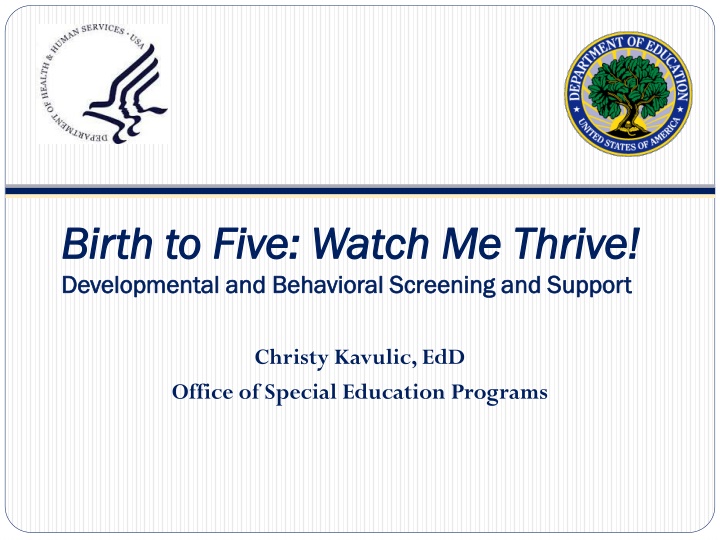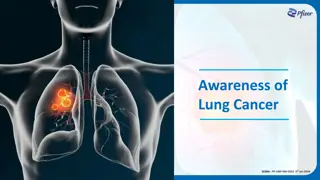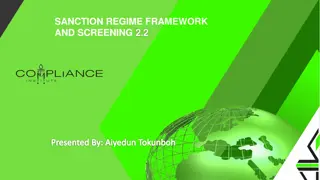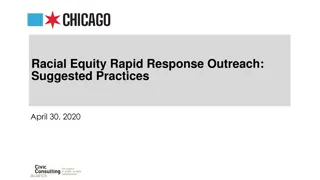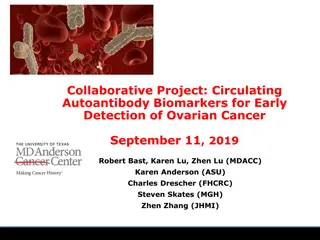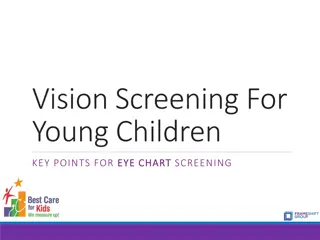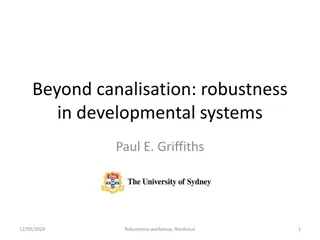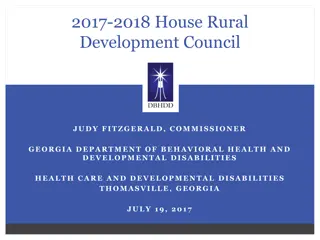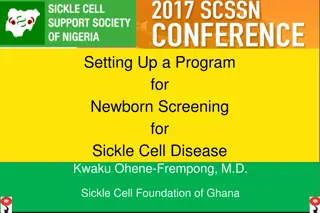Early Developmental Screening and Support Initiatives
Addressing the critical need for early identification of developmental delays in children aged 0-5, this content underscores the importance of comprehensive screening and support services. Highlighting key statistics and recommendations, it emphasizes the significance of timely interventions for improved long-term outcomes, advocating for universal screening and enhanced developmental supports. Partner organizations and a coordinated public outreach campaign are highlighted, promoting awareness and advocacy for child development initiatives.
Download Presentation

Please find below an Image/Link to download the presentation.
The content on the website is provided AS IS for your information and personal use only. It may not be sold, licensed, or shared on other websites without obtaining consent from the author.If you encounter any issues during the download, it is possible that the publisher has removed the file from their server.
You are allowed to download the files provided on this website for personal or commercial use, subject to the condition that they are used lawfully. All files are the property of their respective owners.
The content on the website is provided AS IS for your information and personal use only. It may not be sold, licensed, or shared on other websites without obtaining consent from the author.
E N D
Presentation Transcript
Birth to Five: Watch Me Thrive! Birth to Five: Watch Me Thrive! Developmental and Behavioral Screening and Support Developmental and Behavioral Screening and Support Christy Kavulic, EdD Office of Special Education Programs
The Issue The Issue 1 in 4 children, age 0-5 years, are at moderate or high risk for developmental, behavioral, or social delay AAP recommends screening of all children for developmental, behavioral, and social delays at 9, 18, and 24 or 30 months Less than 50% of pediatricians use valid and reliable screening tools Children who have developmental delays are at greater risk for later emotional and behavioral problems and poor educational achievement
Making sure all of our youngest children are screened and given support early are important priorities for the U.S. Departments of Health and Human Services and Education
The Partners The Partners Administration for Children and Families Administration for Community Living Centers for Disease Control and Prevention Centers for Medicare and Medicaid Services Health Resources and Services Administration Eunice Kennedy Shriver National Institute for Child Health and Human Development Substance Abuse and Mental Health Services Administration Office of Special Education Programs, Department of Education
Birth to Five: Watch Me Thrive! Birth to Five: Watch Me Thrive! Coordinated public outreach campaign to promote awareness of child development and developmental and behavioral screening, referral, and follow-up. Key messages include: Celebrating developmental milestones Promoting universal developmental and behavioral screening Improving early detection Enhancing developmental supports
Birth to Five: Watch Me Thrive! Birth to Five: Watch Me Thrive! Toolkit Toolkit A compendium that reviews implementation, reliability and validity characteristics of screening instruments User guides, designed for providers from multiple sectors and the communities in which they live Collection of resources to bring awareness to parents and providers about healthy child development 1. 2. 3.
Birth to Five: Watch Me Thrive! Birth to Five: Watch Me Thrive! Compendium Compendium First line screening instruments for children, birth to 5 years Pertinent information includes cost, administration time, quality level, training required, and age range covered Reference for early care and education providers, pediatricians, home visitors, child welfare case workers, mental health professionals, early intervention specialists, and various others
Birth to Five: Watch Me Thrive! Birth to Five: Watch Me Thrive! User Guides User Guides Early Care and Education Providers Early Intervention Service and Early Childhood Special Education Providers Families Primary Care Providers Communities Child Welfare Home Visitors Behavioral Health Providers Housing and Homeless Shelter Providers
Birth to Five: Watch Me Thrive! Birth to Five: Watch Me Thrive! User Guides User Guides Developmental milestones Screening, monitoring and surveillance How to engage families in the process How and where to refer if concerns are detected How to choose the appropriate tool to fit the need
Birth to 5: Watch Me Thrive! Birth to 5: Watch Me Thrive! Community Guide Community Guide Broad Community Goals and Strategies for Successful Developmental and Behavioral Screening Initiatives and Community Examples Raise public awareness about the importance of celebrating developmental milestones with children and families, universal developmental screening, risks for developmental delay and supports for those at risk. Engage community leaders. Discover common stakeholder interests and goals. Provide cross-disciplinary training to relevant providers who interact with young children in the administration of standardized, reliable screening tools.
Birth to 5: Watch Me Thrive! Birth to 5: Watch Me Thrive! Community Guide Community Guide Build systems, communication, privacy assurances, and infrastructures 1) Support expanded screening across early childhood programs and providers while minimizing the risk of duplicate screenings, and 2) Ensure that referrals are successful, feedback loops are utilized, follow up and monitoring occurs, and action plans are shared with all who support young families and their children. Improve communication processes across early care and education and primary care. Destroy myths that may act as barriers to action. Take advantage of medical/health home, health information exchange, and health care reform initiatives.
Birth to Five: Watch Me Thrive! Birth to Five: Watch Me Thrive! Resources Resources Information on developmental milestones Every day tips for caregivers to promote healthy development Fact sheets on specific developmental disabilities or delays http://t0.gstatic.com/images?q=tbn:ANd9GcQPn1jlGYlwwh3jhiCbmuyUw27g1Jn6QbS4kQz4q_-t6QtWMJ4Uhg Milestone checklists and tracking tools Learning modules for providers Screening passport for families Guidance for finding help locally
Questions? Questions? Birth to 5: Watch Me Thrive! www.hhs.gov/watchmethrive
